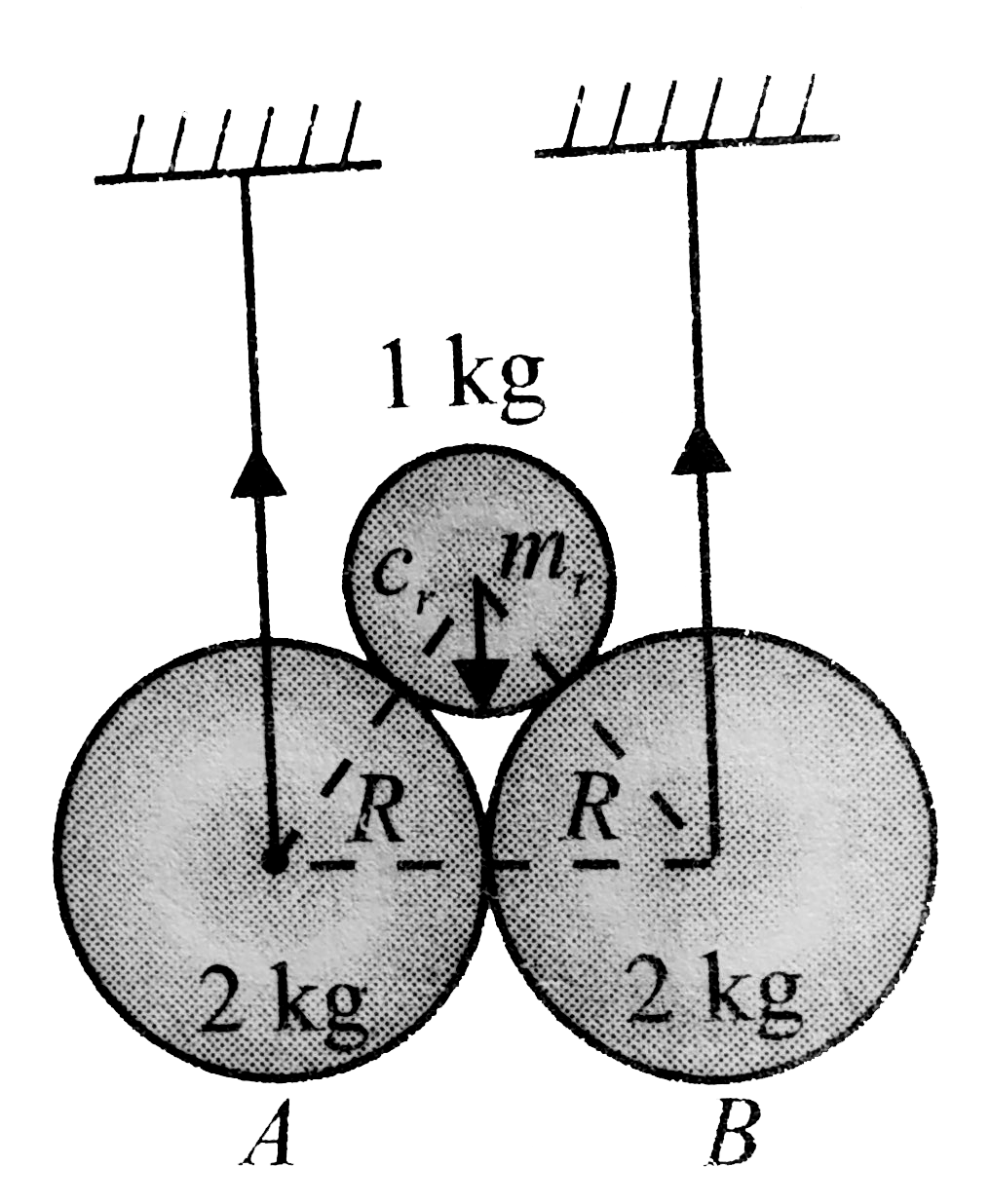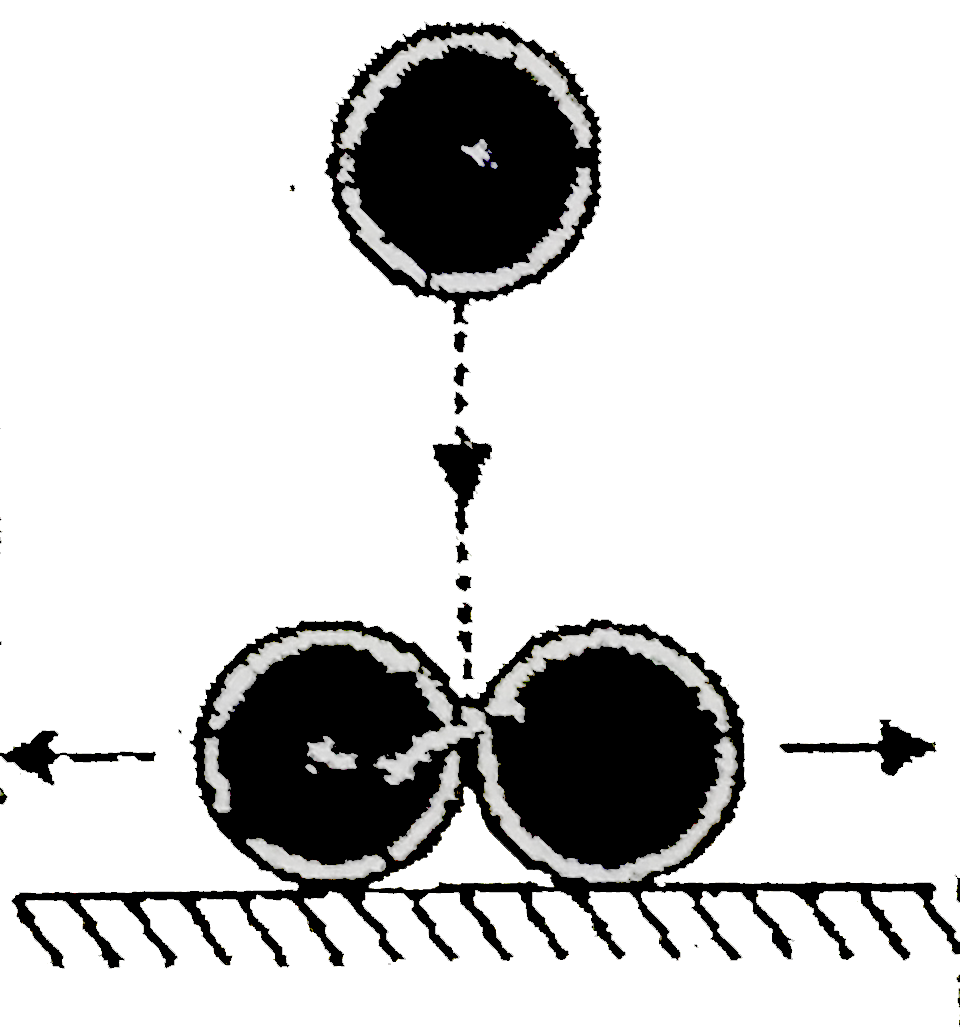Two identical balls A and B. each of mass 2kg and radius R, are suspended vertically from inextensible strings as shown in Fig. The third ball C of mass 1kg and radius r=(√2−1)R falls and hits A and B symmetrically with 10m/s. Speed of both A and B just after the collision is 3m/s.

The value of coefficient of restitution is
14
1√2
√2−1
12
The correct Answer is:D
e=Velocity of separationVelocity of approach
⇒e=3cosθ+V′Csinθ10sinθ⇒e=3+210=12
Topper's Solved these Questions
- CENTRE OF MASSBOOK - CENGAGE PHYSICSCHAPTER - CENTRE OF MASSEXERCISE - Integer
16 Videos
- CENTRE OF MASSBOOK - CENGAGE PHYSICSCHAPTER - CENTRE OF MASSEXERCISE - Fill In The Blanks
2 Videos
- CENTRE OF MASSBOOK - CENGAGE PHYSICSCHAPTER - CENTRE OF MASSEXERCISE - Assertion - Reasoning
2 Videos
- CALORIMETRYBOOK - CENGAGE PHYSICSCHAPTER - CALORIMETRYEXERCISE - Solved Example
13 Videos
- DIMENSIONS & MEASUREMENTBOOK - CENGAGE PHYSICSCHAPTER - DIMENSIONS & MEASUREMENTEXERCISE - Integer
2 Videos
Similar Questions
Two identical balls A and B. each of mass 2kg and radius R, are suspended vertically from inextensible strings as shown in Fig. The third ball C of mass 1kg and radius r=(√2−1)R falls and hits A and B symmetrically with 10m/s. Speed of both A and B just after the collision is 3m/s.

speed of C just asfter collision is
View SolutionTwo identical balls A and B. each of mass 2kg and radius R, are suspended vertically from inextensible strings as shown in Fig. The third ball C of mass 1kg and radius r=(√2−1)R falls and hits A and B symmetrically with 10m/s. Speed of both A and B just after the collision is 3m/s.

Impulse provided by each sting during collision is
View Solution
Knowledge Check
Two identical balls A and B. each of mass 2kg and radius R, are suspended vertically from inextensible strings as shown in Fig. The third ball C of mass 1kg and radius r=(√2−1)R falls and hits A and B symmetrically with 10m/s. Speed of both A and B just after the collision is 3m/s.

speed of C just asfter collision isA2m/sB2√2m/sC5m/sD(√2−1)m/sTwo identical balls A and B. each of mass 2kg and radius R, are suspended vertically from inextensible strings as shown in Fig. The third ball C of mass 1kg and radius r=(√2−1)R falls and hits A and B symmetrically with 10m/s. Speed of both A and B just after the collision is 3m/s.

Impulse provided by each sting during collision isA6√2NsB12NsC3√2NsD6NsTwo smooth balls A and B, each of mass m and radius R, have their centres as shown in fig. Ball A, moving along positive x-axis, collides with ball B. Just before the collision, speed of ball 'A' is 4m/s and ball 'B' is stantionary. The collision

Velocity of the ball 'A' just after the collision isA(i+√3ˆj)m/sB(i−√3ˆj)m/sC(2i+√3ˆj)m/sD(2i+2ˆj)m/s
In the figure shown, the two identical balls of mass M and radius R each, are placed in contact with each other on the frictionless horizontal surface. The third ball of mass M and radius R2' is coming down vertically and has a velocity =υ0 when it simultaneously hits the two balls and itself comes to rest. Then, each of the two bigger balls will move after collision with a speed equal to :

View SolutionIn the figure shown, the two identical balls of mass M and radius R each, are placed in contact with each other on the frictionless horizontal surface. The third ball of mass M and radius R/2, is coming down vertically and has a velocity =v0 when it simultaneously hits the two balls and itself comes to rest. Then, each of the two bigger balls will move after collision with a speed equal to

View SolutionA ball A of mass 3 kg and a ball B of mass 4 kg are moving alogn the same straight line with speeds of 7m/s and 5 m/s respectively. They approach each other and collide. What is the speed of B after collision, If the coefficient of restitution is 34?
View SolutionIn the figure shown, the two identical balls of mass M and radius R each, are placed in contact with each other on the frictionless horizontal surface. The third ball of mass M and radius R/2, is coming down vertically and has a velocity =v0 when it simultaneously hits the two balls and itself comes to rest. Then, each of the two bigger balls will move after collision with a speed equal to

View SolutionIn the figure shown, the two identical balls of mass M and radius R each, are placed in contact with each other on the frictionless horizontal surface. The third ball of mass M and radius R2' is coming down vertically and has a velocity =υ0 when it simultaneously hits the two balls and itself comes to rest. Then, each of the two bigger balls will move after collision with a speed equal to :

View Solution
